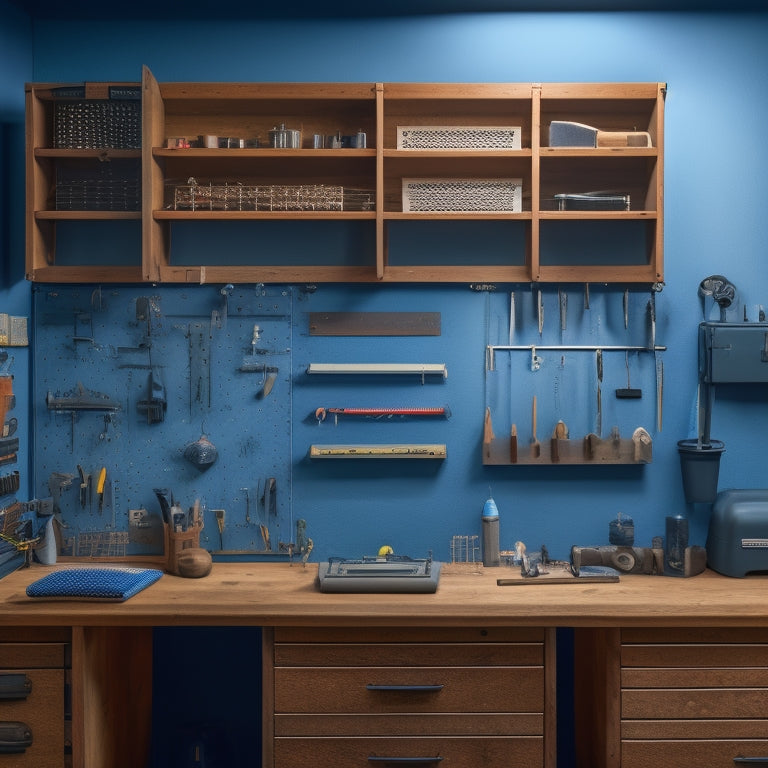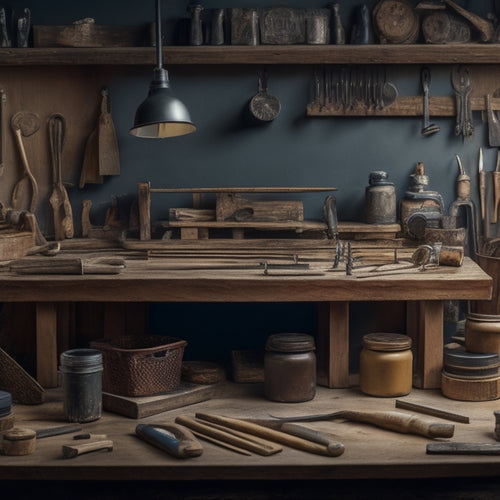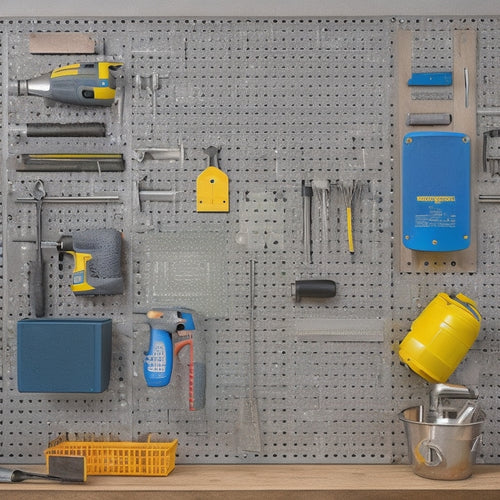
Effortless Tool Storage and Retrieval Solutions Revealed
Share
You're tired of wasting time searching for tools in your cluttered workshop. It's time to create an effortless tool storage and retrieval system. Start by understanding fundamental principles of tool storage, utilizing tool cabinet solutions, and optimizing your workshop layout for efficiency. Consider customizing pegboard systems, maximizing vertical storage space, and streamlining tool retrieval processes. Design a tool organization plan, implement a labeling system, and manage your tool inventory effectively. By maintaining a clutter-free workshop, you'll boost productivity and reduce downtime. With a few simple changes, you can access a more efficient workshop - and discover even more ways to optimize your tool storage and retrieval.
Key Takeaways
• Master tool storage essentials by utilizing tool cabinet solutions, ergonomic tool racks, and mobile tool carts to maximize efficiency and productivity.
• Optimize workshop layout by segmenting into zones, dedicating areas to tasks, and reducing walking distances to stay focused and efficient.
• Customize tool pegboard systems by optimizing tool placement, grouping similar tools, and leaving space for future additions.
• Maximize vertical storage space with shelving units, racks, and overhead storage to free up floor space and reduce clutter.
• Streamline tool retrieval by labeling storage containers, categorizing tools, and designating specific spots for each tool to reduce search time.
Mastering Tool Storage Essentials
You need a solid understanding of the fundamental principles of tool storage to maximize efficiency and productivity in your workspace. A well-organized tool storage system is essential to reduce wasted time searching for tools, minimize fatigue, and prevent accidents.
Tool cabinet solutions and ergonomic tool racks are great options to keep in mind. These solutions provide easy access to frequently used tools, keeping them within arm's reach, and reducing strain on your body.
Mobile tool carts and wall-mounted tool holders are also excellent choices. They allow you to move tools around your workspace as needed, making it easier to complete tasks efficiently. Wall-mounted tool holders keep your workspace clutter-free, providing a clean and organized environment.
Optimizing Workshop Layout for Efficiency
When you're setting up your workshop, optimizing the layout is crucial for maximum efficiency. You'll want to segment your workshop into zones, each dedicated to a specific task or type of project, to reduce walking distances and increase productivity.
Workshop Zone Segmentation
Segmenting your workshop into distinct zones helps streamline tool storage and retrieval, allowing you to optimize your layout for maximum efficiency and productivity. By dividing your workspace into separate areas, you can create a more organized and structured environment that makes it easier to locate and access the tools you need. This, in turn, saves you time and reduces frustration.
Here are some key zones to contemplate:
-
Tool Zone: Designate a specific area for tool storage, such as a pegboard or tool chest, to keep frequently used tools within easy reach.
-
Work Zone: Create a dedicated space for projects and tasks, with a workbench or table and necessary lighting and electrical outlets.
-
Material Zone: Set aside an area for storing materials, such as lumber, pipes, or other project supplies.
- Supply Zone: Designate a zone for storing consumables, like fasteners, adhesives, or paints.
Tool Station Placement
By strategically situating tool stations throughout your workshop, you can greatly diminish walking distances and minimize downtime, allowing you to stay focused on the task at hand. A well-thought-out tool station arrangement can significantly enhance your productivity and efficiency.
Here are some key considerations for ideal tool station placement:
| Tool Station | Placement Considerations | Accessibility Tips |
|---|---|---|
| Power tools | Near power sources, away from foot traffic | Install overhead storage for cords and accessories |
| Hand tools | Within easy reach, near workbenches | Use pegboards or hooks for quick access |
| Measuring tools | Near measurement areas, at comfortable heights | Label and categorize tools for quick identification |
When planning your tool station arrangement, consider the frequency of use, the size and weight of the tools, and the workflow of your projects. By situating your tool stations in strategic locations, you can enhance tool station accessibility and reduce the time spent searching for tools. This, in turn, will help you stay focused on your projects and increase your overall productivity.
Customizing Tool Pegboard Systems
When customizing your tool pegboard system, you'll want to start by considering your pegboard layout options.
You'll need to think about the types of tools you'll be storing and how you'll be using them to optimize your tool placement.
Pegboard Layout Options
You can customize your pegboard system to fit your specific needs by arranging pegs and bins in a way that maximizes storage capacity and efficiency. This allows you to make the most of your available space and guarantees that your tools are easy to access.
Here are some pegboard layout options to ponder:
-
Zone-based layout: Divide your pegboard into zones based on tool categories, such as hand tools, power tools, and accessories. This makes it easy to find what you need quickly.
-
Frequency-based layout: Arrange your tools based on how often you use them. This ensures that your most-used tools are easily accessible.
-
Task-based layout: Organize your tools based on specific tasks or projects. This helps you prepare for upcoming projects and guarantees you have everything you need.
- Hybrid layout: Combine different layout strategies to create a customized system that works best for you.
Optimizing Tool Placement
Set up your tool pegboard system to reflect your work habits and preferences, placing tools that you use together in close proximity to streamline your workflow. This ergonomic tool placement ensures you're not wasting time searching for the right tool, allowing for efficient tool retrieval.
By grouping similar tools together, you'll reduce the distance you need to travel to complete a task, making your work process more efficient.
When customizing your pegboard system, consider the frequency of use and the size of each tool. Place your most frequently used tools in easy-to-reach locations, and reserve lower or harder-to-reach areas for less frequently used tools.
This space-saving storage solution will maximize your pegboard's capacity while maintaining tool accessibility. Don't forget to leave some empty space to accommodate future tool additions or changes in your workflow.
Maximizing Vertical Storage Space
Optimizing your workshop's vertical storage space starts with strategically placing shelves, bins, and hooks to keep frequently used tools within easy reach. By maximizing your vertical storage, you'll free up valuable floor space and reduce clutter.
Here are some effective ways to make the most of your vertical storage space:
-
Install vertical shelving units that can hold bins, baskets, or small toolboxes, keeping items organized and easily accessible.
-
Utilize space-saving racks for storing long-handled tools, such as brooms, ladders, or hoses, keeping them off the floor and out of the way.
-
Hang bins or bags on pegboards or hooks to store small parts, accessories, or supplies, keeping them visible and within reach.
- Consider using overhead storage racks or ceiling-mounted bins to store infrequently used items, freeing up space below for more essential tools and equipment.
Streamlining Tool Retrieval Processes
By implementing a well-structured tool storage system, you can significantly reduce the time spent searching for tools, allowing you to focus on the task at hand. A well-considered tool organization strategy ensures that your tools are easily accessible, making it simple to retrieve the right tool when you need it. This, in turn, boosts your productivity and efficiency.
To streamline your tool retrieval process, consider investing in storage solutions that cater to your specific tool storage needs. For instance, you can use tool chests, cabinets, or pegboards to keep your tools organized and within reach. Labeling your storage containers or compartments can also help you quickly identify where each tool is stored.
Additionally, storing frequently used tools in an easy-to-access location can save you time and energy. By having a system in place, you'll be able to find the tool you need in seconds, rather than wasting precious minutes searching for it. With a little planning and creativity, you can create a tool storage system that works for you, not against you.
Designing a Tool Organization Plan
To create an effective tool organization plan, you'll need to take stock of your tool collection, identifying the types and quantities of tools you have, how they're currently stored, and how you use them. This will help you determine what's working and what's not, and give you a clear idea of what you need to improve.
Here are some key considerations to keep in mind as you design your tool organization plan:
-
Assess your available space: Think about the dimensions of your tool storage area and how you can maximize it with space-saving solutions like pegboards, hooks, and bins.
-
Categorize and group similar tools: Store tools by category, such as hand tools, power tools, and fasteners, to make them easy to find and access.
-
Designate a home for each tool: Assign a specific spot for each tool, so you can develop a habit of putting things back where they belong.
- Consider creative displays: Think outside the box (or toolbox!) and explore DIY tool storage ideas, such as repurposing old pallets or creating a magnetic board for small metal tools.
Implementing a Labeling System
Create a labeling system that clearly identifies each tool's storage location, making it easy to find what you need at a glance. This is essential in maintaining an organized tool storage system. You can use labeling techniques such as color-coding, alphabetical ordering, or categorizing tools by function or type.
For instance, you can label wrenches, pliers, and screwdrivers separately, making it easier to locate a specific tool.
When implementing a labeling system, keep it simple and consistent. Use clear and concise language, avoiding abbreviations or acronyms that might confuse others. Consider using a label maker or printing labels on a computer to make sure they're easy to read.
Organization tips include labeling not only the tool itself but also its storage location, such as a bin or shelf. This way, you can quickly identify where a tool is stored, even when it's not in use.
Managing Tool Inventory Effectively
With your labeling system in place, you're now better equipped to tackle the task of managing your tool inventory effectively, ensuring you have the right tools on hand when you need them. This is vital for maximizing your productivity and minimizing downtime.
Effective inventory management involves regularly tracking and updating your tool collection to identify what you have, what you need, and what's missing.
Here are some key strategies to help you manage your tool inventory effectively:
-
Conduct regular tool audits: Schedule regular audits to inspect your tools, identify missing or damaged items, and update your inventory list.
-
Use tool tracking software: Utilize digital tools to track your inventory, monitor tool usage, and receive alerts when it's time to restock or replace tools.
-
Implement a check-in/check-out system: Designate a system for borrowing and returning tools to prevent loss or misplacement.
- Maintain a master inventory list: Keep a detailed list of all your tools, including quantities, locations, and maintenance schedules.
Maintaining a Clutter-Free Workshop
By implementing a few simple habits and strategies, you can maintain a clutter-free workshop that allows you to focus on the task at hand and avoid wasting time searching for misplaced tools. Start by adopting a minimalist storage approach, where every item has a designated place and is easily accessible. This will help prevent clutter from building up in the first place.
Next, establish regular decluttering strategies to keep your workshop organized. Set aside time each week to tidy up and get rid of any unnecessary items. This will help you stay focused on the task at hand and avoid distractions.
Consider implementing a 'one in, one out' policy, where you get rid of an old tool or material every time you bring a new one into the workshop.
Frequently Asked Questions
How Do I Prevent Rust on Metal Tool Storage Components?
To prevent rust on metal tool storage components, you'll want to apply rust prevention techniques, such as coating with wax or silicone, and guarantee proper maintenance, like regular cleaning and drying, to keep your tool storage components rust-free.
Are Tool Storage Solutions Suitable for Small Workshops?
"You're the master of your tiny workshop, just like Leonardo da Vinci in his Renaissance studio! You'll find tool storage solutions perfect for small spaces, focusing on maximizing space with portable options that'll keep your tools within easy reach."
Can I Customize Tool Storage for Left-Handed Users?
You can customize tool storage for your left-handed needs by opting for ergonomic designs that cater to your comfort and ambidextrous options that allow for flexible adjustments to suit your unique workflow.
What Are the Benefits of Using Clear Storage Bins?
You'll boost organizational efficiency and space optimization by using clear storage bins, allowing you to easily see and access what's inside, saving time and reducing frustration when searching for specific tools.
Can Tool Storage Solutions Be Adapted for Outdoor Use?
Imagine your tools scattered like confetti in the backyard – not a pretty sight! You can, however, adapt tool storage solutions for outdoor use with weatherproof options and portable solutions that can withstand the elements.
Related Posts
-

What to Look for in a Pegboard Tool Storage Kit
When shopping for a pegboard tool storage kit, you need a system that combines customized organization, sturdy durabi...
-

Top 5 Small Tool Organizers for Your Workshop
You're looking to optimize your workshop's efficiency with high-quality small tool organizers. Compact storage soluti...
-

How to Hang a Pegboard in 5 Easy Steps
You'll hang a pegboard in 5 easy steps by first preparing the wall, ensuring it's sturdy and free of obstructions. Ne...


